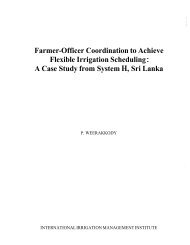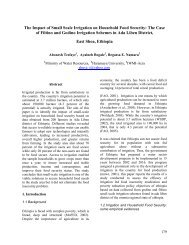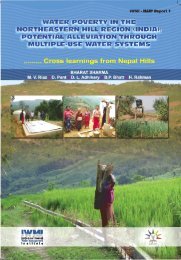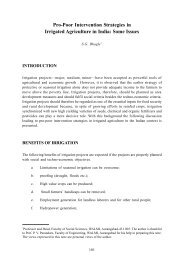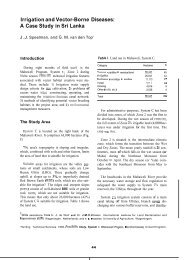INSTITUTION BUILDING AND RURAL DEVELOPMENT IN NEPAL ...
INSTITUTION BUILDING AND RURAL DEVELOPMENT IN NEPAL ...
INSTITUTION BUILDING AND RURAL DEVELOPMENT IN NEPAL ...
You also want an ePaper? Increase the reach of your titles
YUMPU automatically turns print PDFs into web optimized ePapers that Google loves.
2. Assess the capacity of the command units in terms of their accessibility<br />
and the extent of the Committee’s ability to distribute irrigation resources<br />
equitably;<br />
3. Identify the relationship betweer the status of the system and the<br />
Committee’s ability to meet the system’s maintenance requirements.<br />
METHODOLOGY<br />
Comparative analysis was used on information primarily gathered from<br />
organizational groups. Three groups were identified to meet the first objective<br />
of the study: the users’ representatives, panchas, and public personnel involved<br />
in the Committee. The first group was categorized into classes in terms of<br />
land holding, ethnic group, and location status. Panchas were divided into<br />
incumbents and landholders. The public personnel were from agricultural and<br />
irrigation sectors.<br />
To meet the second objective, the general users were taken as the<br />
reference group. They were organized into command units in terms of each<br />
unit’s access to the irrigation facilities: head, middle, and tail.<br />
For the third objective, attitudes of members of organizational groups<br />
towards resource mobilization to operate and maintain the system were<br />
identified. Information was sought on the formal (government) and informal<br />
(users) systems of operation and investment management. Members’ attitudes<br />
towards public property, sanctions, and awareness of the status of the system<br />
vis-a-vis their values and expectations were ascertained.<br />
The study was mainly empirical. All the members of the Water Users’<br />
Committee (WUC), 20 percent of households in the command area (20 households<br />
each in the head, middle, and tail units of the command, chosen at random from<br />
lists obtained from the Subdivisional Irrigation Office in Battar, Nuwakot), and<br />
relevant persons associated with the system were separately interviewed.<br />
Participant observation provided insight into the workings of the Committee.<br />
Gadkhar Irrigation Project was visited in June and August, 1986. Secondary<br />
data was collected from the WUC’s Minute Books, the DIHM (Department of<br />
Irrigation, Hydrology and Meteorology), the Central Region Irrigation<br />
Directorate, and Battar Irrigation Subdivision Office (ISO).<br />
BACKGROUND<br />
Gadkhar Irrigation Project (GIP), which covers 105 hectares (ha) of land,<br />
lies in Choughada village panchayat of Nuwakot district, in the Central<br />
Development Region of Nepal. GIP is 12 kilometers (km) southeast of Trisuli,<br />
the district headquarters. Trisuli is linked to Kathmandu by a 70 km secondary<br />
highway, built to transport materials and labor for the construction of the<br />
Trisuli Hydel Plant in 1965. Gadkhar is difficult to reach by vehicle, especially<br />
in the monsoon, as there is no bridge over the Tadi River which separates the<br />
village from the mud road that starts off from Gungate, on the Kathmandu-<br />
Trisuli highway.<br />
External Assistance<br />
-47-



